Testing in agile – what are the benefits?
The term "agile" was first used by computer engineers in 2001 to describe a collaboration-driven and efficient method of developing software. Agile testing, a subset of this methodology, extends these principles to the testing phase, prioritizing swift delivery of top-notch software with customer feedback at the forefront.
Those who embrace Agile testing can witness elevated code quality, quicker turnaround times, and enhanced scalability and flexibility, specifically compared to traditional Waterfall methodology. So, let's look at what it means to test in Agile and the benefits below!
What is testing in Agile?
Agile testing follows the principles of Agile software development:
- Early and continuous testing: Testers commence testing the software early in the development phase and continue testing it consistently throughout the cycle.
- Whole team approach: All team members, including developers, testers, business analysts, and product owners, share responsibility for ensuring product quality in Agile development.
- Frequent deliveries: Agile teams deliver functioning software every two weeks, ensuring continuous progress and feedback.
- Close collaboration: Agile projects foster close cooperation between team members, promoting transparency and alignment to prevent surprises.
- Customer involvement: Customers actively engage throughout the Agile process, providing feedback in each iteration to facilitate ongoing improvements.
- Focus on working software: Agile teams prioritize delivering quality software in each iteration over extensive documentation or other deliverables.
- Flexible approach: Agile development embraces flexibility, allowing teams to adapt requirements as needed throughout the development process
In agile teams, testing is not considered separate from the SDLC but an integral part. Therefore, those practicing agile use continuous testing. This means they start testing right at the beginning of the SDLC and continue to test throughout.
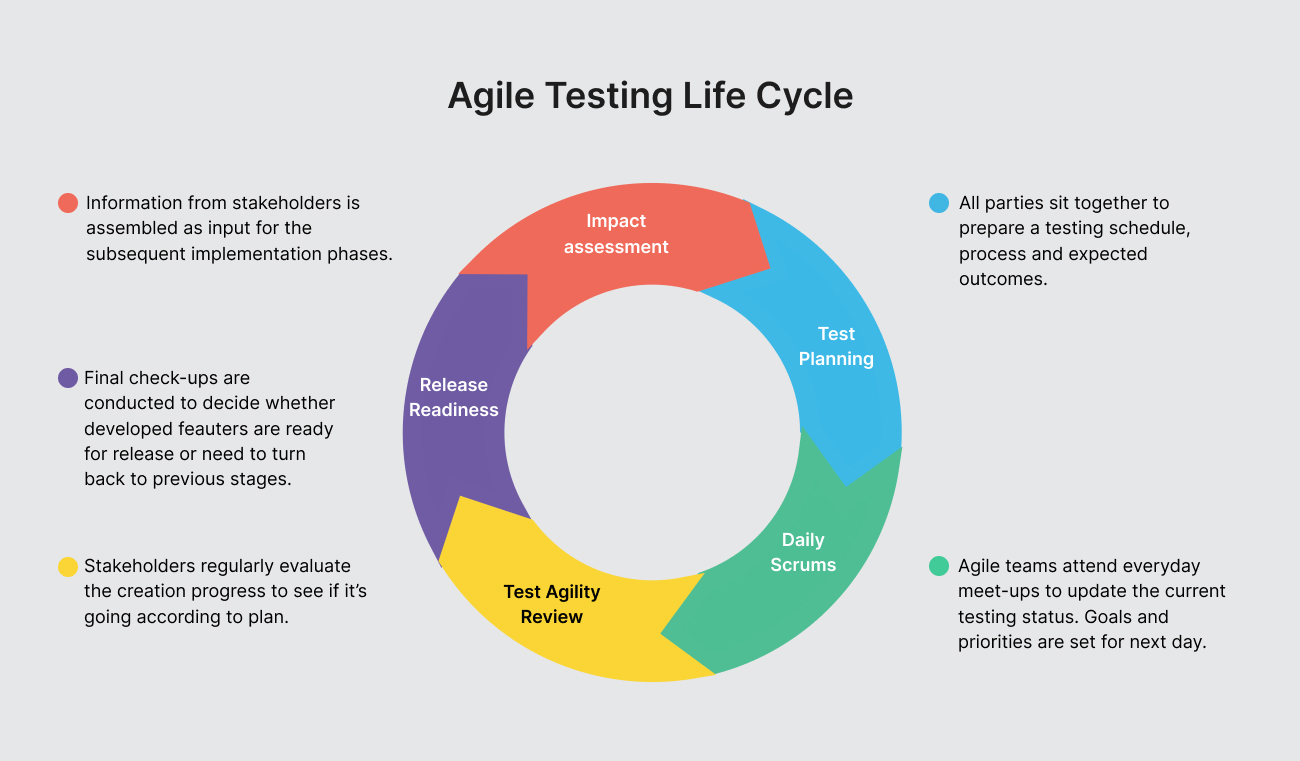
There are fast feedback loops between testing and development, and the process is fluid and reactive rather than sequential (like in Waterfall).
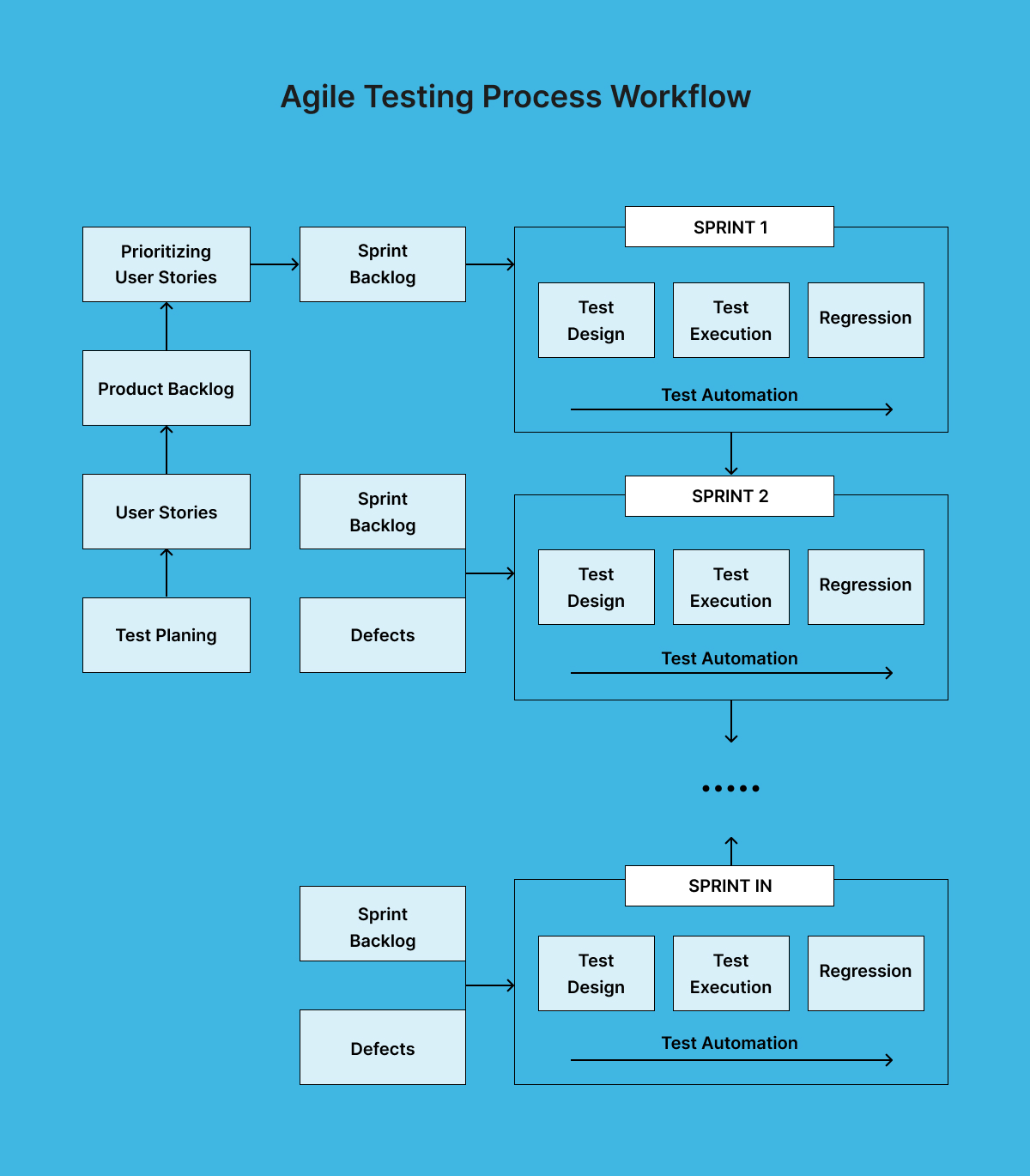
Developers and testers work collaboratively in 'sprints' (short, time-boxed periods) to deliver software. There is a strong cohesion between sub-teams, and testing is conducted early and often rather than simply after the code is finished.
What are the essential abilities of agile testers?
The key skills for agile testers encompass the following:
- Effective communication skills: Testers should communicate proficiently with team members and comprehend customer needs and requirements.
- Proficient technical skills: They must robustly understand code and the technology stack.
- Sharp problem-solving skills: Testers must swiftly identify and resolve issues, exhibiting creativity and adaptability in devising solutions.
- Collaborative teamwork: Testers should excel in team environments, demonstrating flexibility, adaptability, and composure under pressure.
What are the benefits of agile testing?
Agile testing helps to ensure that software satisfies the customer's requirements and that software is always improving. Below are some key benefits of using it:
1. Accelerated execution
The implementation of automation enhances development efficiency. With testing conducted at each phase, any issues or bugs are promptly identified and addressed, adhering to the principle of "fail fast." Early detection of glitches simplifies and reduces the cost of rectification. This time-saving practice holds true even for intricate and complex systems.
Automated testing, particularly at the code unit level, ensures that code undergoes testing from its initial stages, preventing the passage of defects. Continuous testing further diminishes the time-to-market for software. Consequently, developers and testers can allocate more time crafting compelling features instead of bogging down by testing procedures.
Pro tip
By executing simple tests in just hours, you can save a day per cycle, allowing for efficient time management at every touchpoint between engineering and QA. This includes executing tests on every device and in every environment without any set-up hassle, thereby enabling a virtuous cycle of automation for streamlined processes.
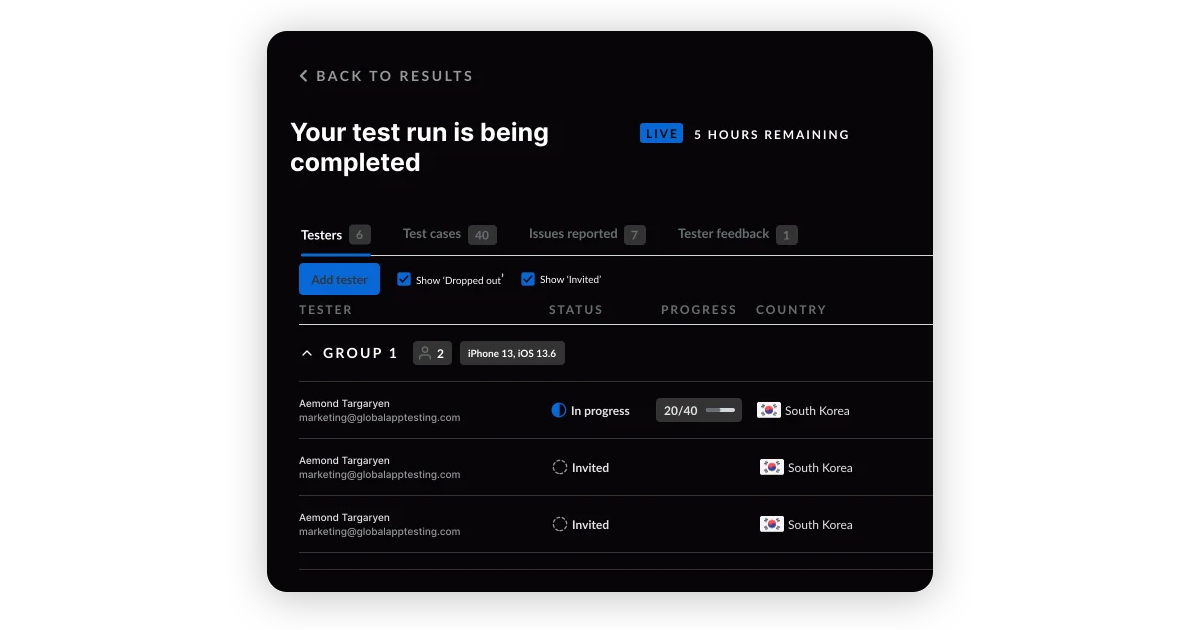
With our services, you can expect:
- Rapid turnaround times, 24/7 launches, and real-time results, along with the capability for unlimited simultaneous testing to ensure thoroughness and efficiency in obtaining results.
- Pinpointing bugs with precision, providing comprehensive bug environment reports, video recordings of bugs, and easy-peasy retests for swift resolution and enhanced debugging processes.
- Agile-enabled approach allows you to invest more time in coding while experiencing fewer production bugs, thanks to our ShiftLeft methodology, ultimately leading to smoother and more efficient software releases.
2. Enhanced precision
Repeatedly testing a scenario can become tedious, leading even proficient testers to inadvertently make errors. They may overlook specific steps or skip them altogether. However, when a meticulously designed automation suite is employed, it guarantees the consistent execution of all steps, thereby enhancing product quality.
Automated testing not only ensures thorough execution but also records all results for team review and adjustments as needed. Additionally, automated tests facilitate code refactoring, enabling modifications to improve performance. With automation, testers can seamlessly implement changes and run tests to assess their impact.
3. Early problem identification
Agile's sprint-based approach facilitates the early detection of issues. Traditionally, testing occurs as a distinct stage after the completion of a product. However, this can lead to significant challenges if testers uncover bugs affecting the product's fundamental aspects. Addressing core issues within the codebase can result in substantial delays and disruptions.
Agile mitigates this risk by incorporating testing throughout every stage of development. This proactive approach ensures that issues are identified and addressed promptly, minimizing the potential for significant setbacks.
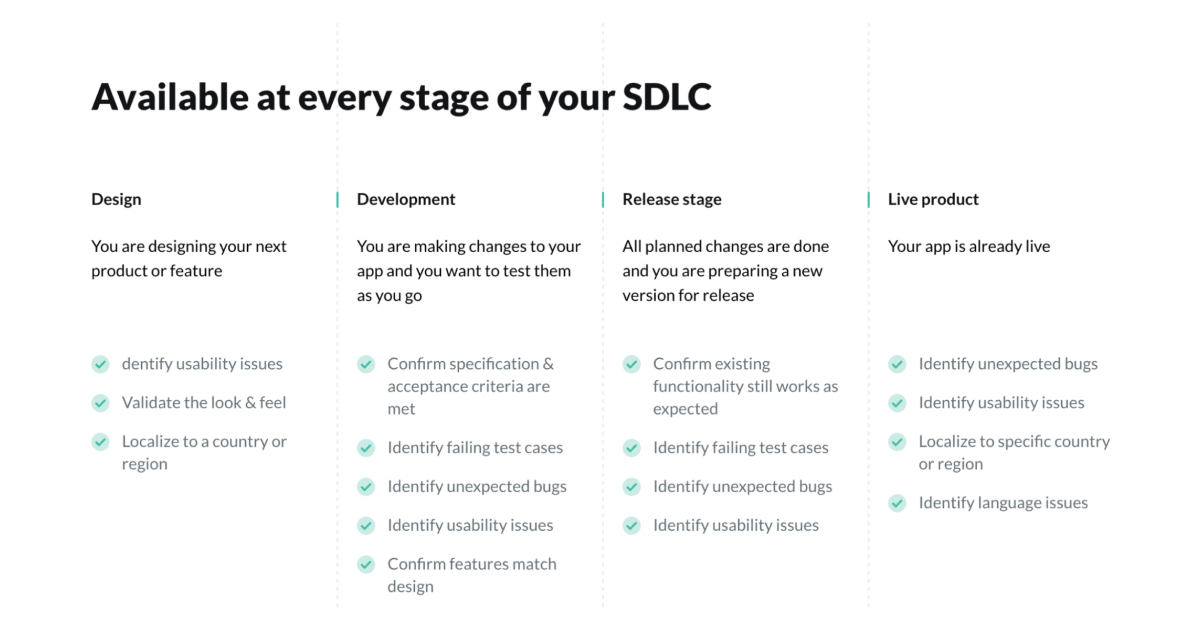
4. Enhanced collaboration
At the core of agile testing lies a focus on teams, individuals, and interactions. Team members engage closely to discuss setbacks, tool preferences, and methodologies. Testers collaborate with developers, business analysts, the Scrum Master, and the Product Owner throughout their sprints. These interactions foster agility in the testing process.
5. Top-notch product quality
In contrast to traditional testing methods, where testing occurs towards the end of development, Agile testing initiates at project inception. This early involvement enables testers to address issues promptly throughout the project lifecycle. Agile fosters close collaboration between testers and developers, ensuring their skills are effectively utilized. Continuous feedback loops facilitate swift bug resolution. Moreover, testers and developers engage directly with customers, leveraging their input to craft a superior-quality product.
6. Reduced documentation
Agile development encourages teams to prioritize documentation only when essential. Excessive documentation in an agile environment heightens overall project risk by limiting change adaptability.
7. Meaningful metrics
Agile teams utilize more accurate and pertinent metrics for forecasting time and cost and monitoring project progress compared to traditional methods. While Waterfall metrics primarily gauge adherence to predetermined cost and time projections, Agile concentrates on delivering outcomes and enhancing performance. For example, Agile generates vital metrics such as lead time, cycle time, and throughput, aiding in evaluating team performance, pinpointing bottlenecks, and making informed, data-driven decisions to address them.
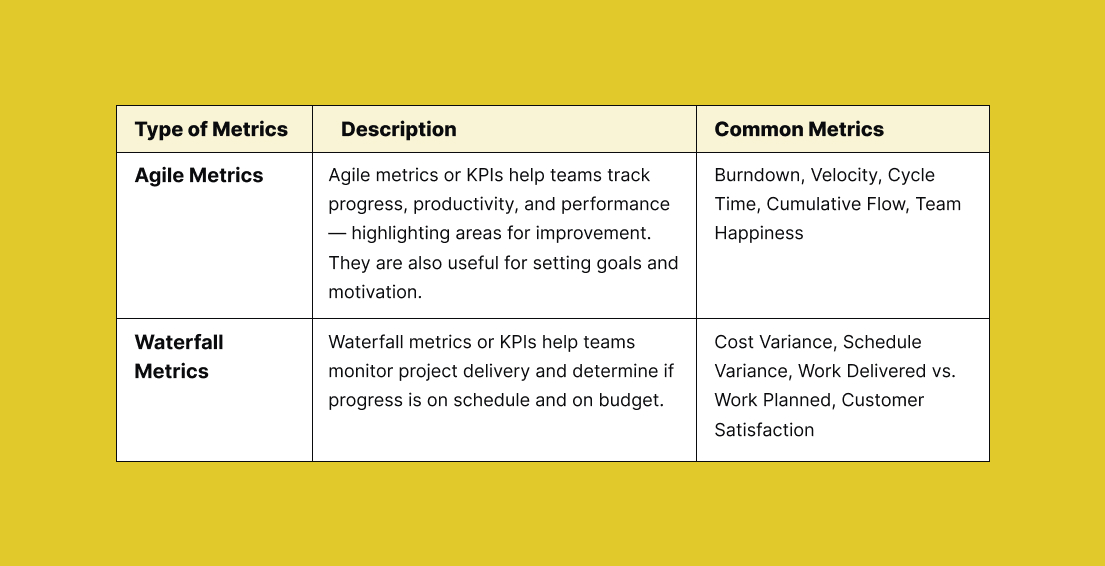
But don't just take our word for it. We asked tech experts to see if they agreed.
“The greatest benefit of agile testing is lightweight test documentation — QA specialists focus not on writing multiple test plans, test cases, test reports, bug reports, but on making sure that the solution is of high quality. As the agile manifesto states, 'Working software over comprehensive documentation.' Another important advantage is the agility of the testing process and its readiness to respond to changeable requirements”
- Alex Pletnov, CTO at KeenEthics,
“Rapid feedback loops are essential to business agility. Agile testing validates our assumptions immediately, so we can adapt quickly and provide increments of value to our customers.”
- Jill Stott, Agile trainer and coach at NextUp Solutions
“Sync agile testing is quick and it is ideal for testing the performance of small projects. What’s more, revisions during the middle of the project are possible. With the fast nature of agile testing, QA testers can perform tests even before the project finishes. Finally, minimal planning is required. Since agile testing doesn’t require a multitude of documentation, it is easier and faster because of its unstructured nature.”
- Jonathon Wright, Management Consultant, QA Lead
How to test in Agile successfully?
Implementing an agile strategy demands a restructuring of your current SDLC and workflows. This change means you can be thrown into an unknown world, and you may face setbacks.
But that's okay. Every new strategy needs a settling-in period. And Agile testing is worth it.
So, how do you ensure that you implement testing in Agile successfully without facing hiccups along the way? Hear from our experts:
“High-quality, well-planned automated tests are indispensable. Without a fast-running, reliable automated test suite it is nearly impossible for teams to complete each iteration with a potentially shippable increment of value.”
- Jill Stott, Agile trainer and coach at NextUp Solutions
“Communicate and adhere to a strong 'definition of done'. Testing will never be perfect and with agile testing, one needs to integrate the operations team as well to consistently roll out products. This requires operations and development to be strongly aligned and have a clear definition-of-done, facilitated through direct and regular communication.”
- David Johnson, Chief Technology Officer, Mulytic Labs and founder of Clear Blue Data
“I recommend not keeping QAs closed in their cubicles as some old-fashioned testing approaches presume but letting them interact continuously with developers, PMs, POs, and clients. It will give QAs a bigger picture of the entire project and make the testing process both more effective and more efficient."
- Alex Pletnov, CTO at KeenEthics
How to embrace the Agile approach
Implementing Agile is similar to any change in your company - it comes with challenges.
But it also comes with opportunity. At Global App Testing, the Agile approach involves embracing change, continuously seeking improvements, and prioritizing customer satisfaction. Our services enhance product quality, delivering superior software, improving customer satisfaction, and boosting your business's bottom line:
- Easy test management: GAT offers a user-friendly platform for easy test creation and management, consolidating all testing activities in one place. Additionally, it enables test execution through a network of over 90,000 professional testers.
- Quick test execution: With an average test case turnaround time of 60-150 minutes, GAT ensures swift execution of tests, expediting the feedback loop in the development cycle.
- 24/7 access: Enjoy round-the-clock access to GAT's platform, allowing continuous, on-demand testing to meet your project needs effectively.
- In-app results and analysis: GAT provides in-app results and analysis, simplifying the interpretation of raw data and facilitating quick insights into test outcomes through user-friendly formats.
If you would like to learn more about delivering quality at speed, book a call with one of our growth specialists today!
We can help you drive localization as a key initiative aligned with your business goals
FAQ
How does Agile testing differ from traditional testing?
Unlike traditional testing, which often occurs as a separate phase after development, agile testing is integrated throughout the development process. It emphasizes adaptability, collaboration, and delivering working software in short iterations rather than focusing solely on documentation and adherence to a predetermined plan.
What tools and techniques are used in Agile testing?
Agile testing employs various tools and techniques, including:
- Test automation frameworks (such as Selenium and Cucumber)
- Continuous integration servers (like Jenkins and Travis CI)
- Behavior-driven development (BDD)
- Acceptance test-driven development (ATDD), and
- Exploratory testing methods (such as those provided by Global App Testing).
How to implement Agile testing within your team?
Successful implementation of agile testing requires:
- Commitment to Agile principles and values,
- Fostering a culture of collaboration and continuous improvement
- Investing in appropriate tools and training
- Ensuring clear communication among team members and stakeholders, and
- Regularly reflecting on and adapting processes to optimize effectiveness.
Keep learning
How much does software testing cost in 2025?
5 Beta testing iOS apps to help you build functional products
10 Mobile app testing best practices

